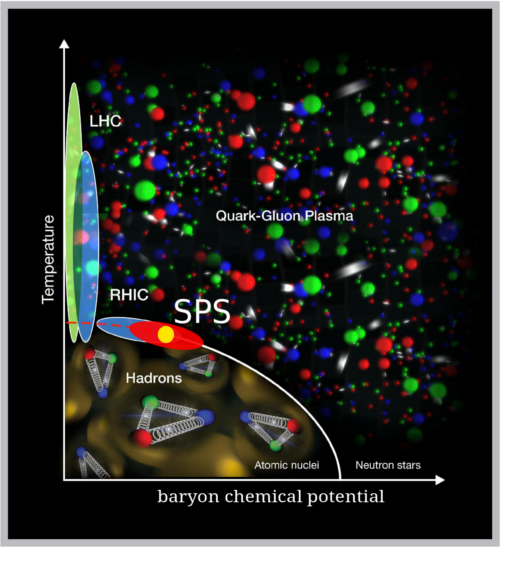Strong interactions
 NA61/SHINE is the successor experiment of NA49 which studied the energy dependence of hadron production in Pb+Pb interactions. Within this programme, the threshold for the quark-gluon plasma creation - the onset of deconfinement - was discovered. NA61/SHINE aims to uncover properties of the onset of deconfinement by systematic and precise measurements of collision energy and nuclear mass dependence of its signals. It is also looking for evidence of a critical point on the transition line between two phases of strongly interacting matter: quark-gluon plasma and hadron gas.
NA61/SHINE is the successor experiment of NA49 which studied the energy dependence of hadron production in Pb+Pb interactions. Within this programme, the threshold for the quark-gluon plasma creation - the onset of deconfinement - was discovered. NA61/SHINE aims to uncover properties of the onset of deconfinement by systematic and precise measurements of collision energy and nuclear mass dependence of its signals. It is also looking for evidence of a critical point on the transition line between two phases of strongly interacting matter: quark-gluon plasma and hadron gas.
The fact that quark-gluon plasma is created at collision energies available at RHIC does not arouse serious doubts. However, a questionable issue is the minimum collision energy (threshold energy) at which plasma is being created. There are serious arguments in favour of a hypothesis that the threshold center of mass energy is as low as 8 GeV per colliding nucleon pair (it corresponds to the beam energy of 30 GeV in the frame of a stationary target). This is because at this energy in the NA49 experiment, in collisions of the heaviest nuclei, irregularities of three physical observables as functions of collision energy were observed:
- a strong maximum of the ratio of K+/π+ multiplicities (horn)
- flattening of an inverse slope of transverse momentum distribution of K+ (step)
- a change of a slope of negatively charged hadrons multiplicities (kink)

A question arises: at what size of colliding nuclei these qualitative changes appear? A precision study of observed effects, which are likely to be caused by traversing the threshold for the quark-gluon plasma production, and an analysis of other characteristics of a collision, especially fluctuations of various observables, in a range of energies around 8 GeV at the center of mass in interactions of light nuclei, is the main goal of the NA61/SHINE experiment. In comparison to NA49, the NA61/SHINE experiment will broaden the list of studied characteristics of colliding nuclei, especially including fluctuations of various physical quantities which are sensitive to the phase transition. We plan to investigate fluctuations of multiplicities of produced particles, of their transverse momenta and of chemical composition of the final state of the collision. The ion collisions program was started in 2009 and will be continued until at least 2017.

